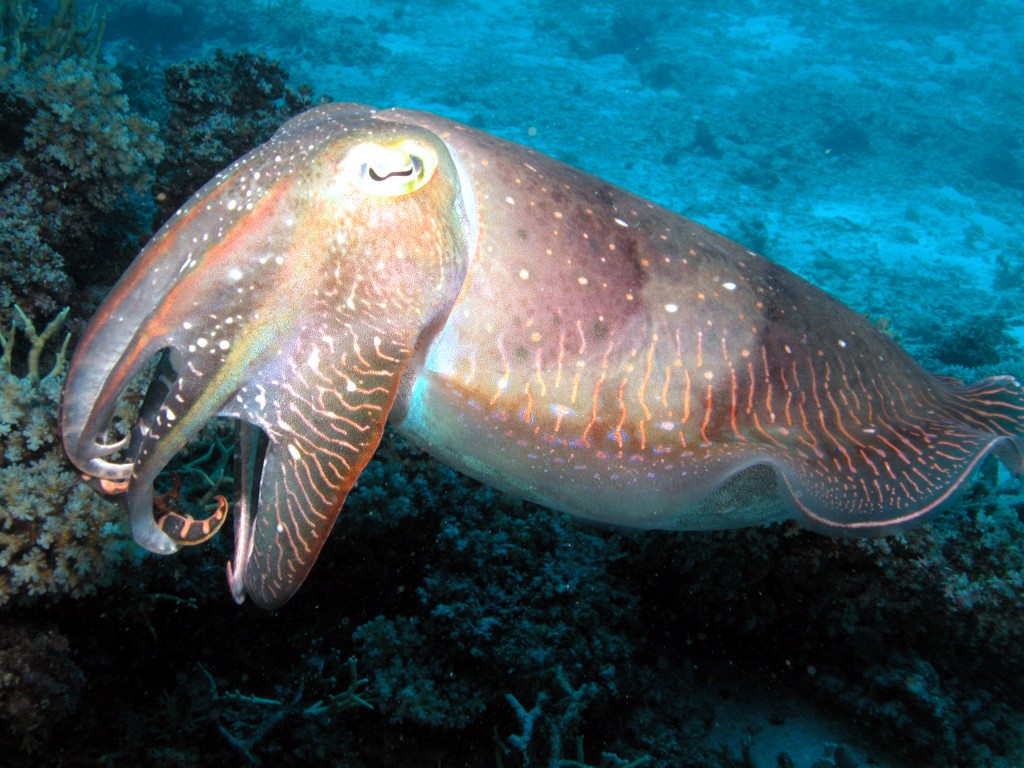
The Cuttlefish has the amazing ability to mimic almost every single colour found on the Great Barrier Reef
Passengers are forever making comments about the amazing colours of our tropical reef fish. From the brilliantly patterned wrasses, to the intricate markings of the juvenile angelfish, it is the one common topic that is discussed on the way back from a successful day on the reef. But why do these fishes have such varied patterns and colours?
One of the most important reasons is communication. With most fish lacking any form of vocalization, the only way to communicate is by sight. This is very important at breeding time, when many species are making good use of the water conditions (i.e. right tides, right temperature, etc), and ensuring that they are mating with a fish of the same species. Some fish will drastically change colours when about to breed, such as blue-green chromis. These fish, normally blue-green as the name suggests, change to a dramatic yellow with a black vent when about to breed. Other fish have exotic patterns and colours on their fins, which they flash around when trying to woo a mate.
Many territorial fish have the ability to manipulate their colours to a degree. If threatened, some will adopt dark bands across their bodies, such as coral trouts, trying to intimidate any invaders. Some fish will take on an overall darker hue when resting/sleeping, such as butterflyfish, to avoid detection.
Indeed, camouflage is also a major factor in the variation in Colour of fishes. If you’re not trying to sneak up and eat someone else, someone else is probably after you! Butterflyfish usually have a dark band through their eye, concealing it, whilst having a false eye spot on or near their tail. As these fish feed on benthic material, and often have their heads in holes, they often leave the rear of their bodies vulnerable. By having this false eye means that it offers some protection against predators.
Fish generally produce lots of juveniles, in the hope that some will survive to breeding age. When you’re young, the most important thing in the world is to survive, and many have lots of stripes and spots so that they blend in with the equally colourful background of the coral reef. As you get older, the pendulum swings, and it becomes more important to take the chance and breed, and there is often a corresponding change in Colour to the adult stage, which is recognized by members of the same species. Parrotfish are a good example of this, with one species, Cetoscarus bicolor , starting life as white with an orange band around its midriff, and changing to a magnificent, multi-coloured adult.
Some fish are incredibly poisonous to eat, and like to advertise that fact with bright and contrasting colours, such as the splendid Clown triggerfish. These fish don’t need to skulk around the shadows; they openly flaunt themselves, knowing that only the most foolish of predators will attack. Fish such as the poisonous (to touch) lionfish, also have exquisite colours, but are predominantly red, which is a well known danger Colour.
As you descend in the water column, certain light spectrums are absorbed, the last being blue to black. The best camouflage colour at this depth is red, and most deep water fish are in fact red in Colour (think of squirrel fish and red emperors). In fact, red is the easiest Colour for fish to adopt, as the compounds required to formulate that Colour are readily (no pun intended!) found in their natural diets.
So next time you are snorkeling or diving, look at the colourful fish from a different perspective.

